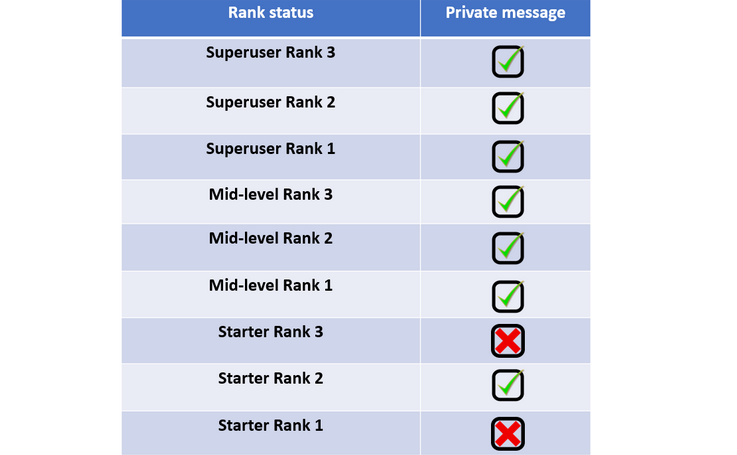The ranking structure should be a central piece of your Gamification strategy. Even if you might doubt it, many users are aware of it and will be motivated to stay active so they will make it to the next rank. A ranking structure will also make it easier for visitors to understand who they are speaking to. A reply coming from a true expert and veteran of your community will have more impact on visitors than a reply from a newbee...
This tutorial will guide you through the process of defining your ranking structure, no matter if you are just starting with your community or if you want to review your existing ranking structure.
Some general rules before we start
There are some general principles which we want to share with you when you are changing your ranking structure:
- Rank rules should always reward behavior that matches the goal of your community
- The higher the rank, the harder it must be to achieve it
- Do not send too many notifications for lower ranks
- Rank names should indicate if a user is new / more experienced than a lower rank
- Ranks should differentiate from each other in styling (color, bold, underlined, etc.)
Rank styling
There are several styling options which you can use for your ranks. This way your users can identify easier who is more experienced / which ranks are higher.
Rank / Username icons
You can define these icons to be displayed in the following locations:
This can be handy for Super users (to show they are special), but it can also be used for your Community team (e.g. use the company logo).
Bold/Italic/Underlined
You can use these options to differentiate levels of a rank group (for example the first three starter ranks): Rank 1 Rank 2 Rank 3
Creating a ranking structure for a new community
For a new community it can be really difficult to determine how active users will be and how "fast" they will progress through the ranking system. This is why you can find a default ranking structure attached to this tutorial! :)
For most communities, this setup will be just fine for the first 6-12 months after go-live. After that we recommend you to review it, to make sure that users can still earn higher ranks and that the "journey" through your ranking system works smoothly.
You will find a tutorial on how to configure ranks by following this link.
Review a ranking structure for a mature community
We recommend you to review your ranking structure at least once a year. The older your community gets, the more users you will find in the top ranks. Make sure that they always have something new to achieve!
Step 1: Review the current performance
There are multiple ways to get an overview of the performance of your ranking structure:
User exports ([Analytics] - [Exports])
After the export has downloaded, open it and create a pivot table. Check the distribution of users amongst the ranks.
If you want to, you can also have a look at the distribution of user activity (e.g. average comments or topics) to get an indication for your rank rules)
Member Dashboard ([Analytics] - [Members Dashboard])
In the Member Dashboard you can easily see the distribution of ranks in the bottom right table.
Note: If a rank name does not show, it means that nobody has that rank. Also make sure to disable the date filter (top right)
Rank overview ([General settings] - [Ranks])
In this page you will find the column "users". It indicates how many users currently are at a certain rank level.
Note: The [Rebuild]-button at the top of the list will recalculate the user activity, so that all ranks will automatically be recalculated for each user.
Ask yourself when you look at the distribution of ranks:
Are there "gaps" in your ranks, where no users own a rank?
Are there "barriers" that keep users from progressing forward?
Step 2: Balance the ranking structure
If the majority of users sits in one rank, see if you can spread it out a little bit, by either lowering the rules for the next rank, or by adding new ranks in between which make it easier for users to reach the next level. Hand rule here: After a change, users should ideally rank up and not down. Otherwise they might be disappointed (especially superusers).
It is important note that the order or ranking matters. If a rank is placed at the top and the user has that rank (like employee) no matter how many contributions the user makes they can not advance forward.

Tip: The ideal ranking structure has intervals of 2.5x: If the first rank starts with e.g. 1 reply, then the second one should be at 3 replies, the next one at 7.
Tip 2: Users are less likely to start new topics the "higher" their rank is (as they will reply more to questions / discussions started by new members). So make sure to not set the barrier too high when it comes to creating new topics.
Step 3: Test it's performance
Now it is time to push the "rebuild" button. 🙂 By doing so, all user activity is being recalculated, and users will receive the ranks according to your new rank system. If you don't push this button, then ranks will be calculated per user when they log in or when they are active.
Step 4: Review notifications
You want to change the notifications after you have rebuild the ranking structure. Why? Because otherwise a bunch of users would receive a rank up notification "out of the blue" and without them being active on the community. That would feel weird. If you add these notifications after the recalculation, those messages will only be send once a user reaches that rank through their activity.
Step 4: Announce and release it
Now you only need to let your users know about the changes. But be careful: Don't tell your users exactly what they need to do in order to reach the next rank. Otherwise they will cheat the system and spam your community.
Need help with optimizing your ranking structure? Don't hesitate to comment or to start a new question! :)








